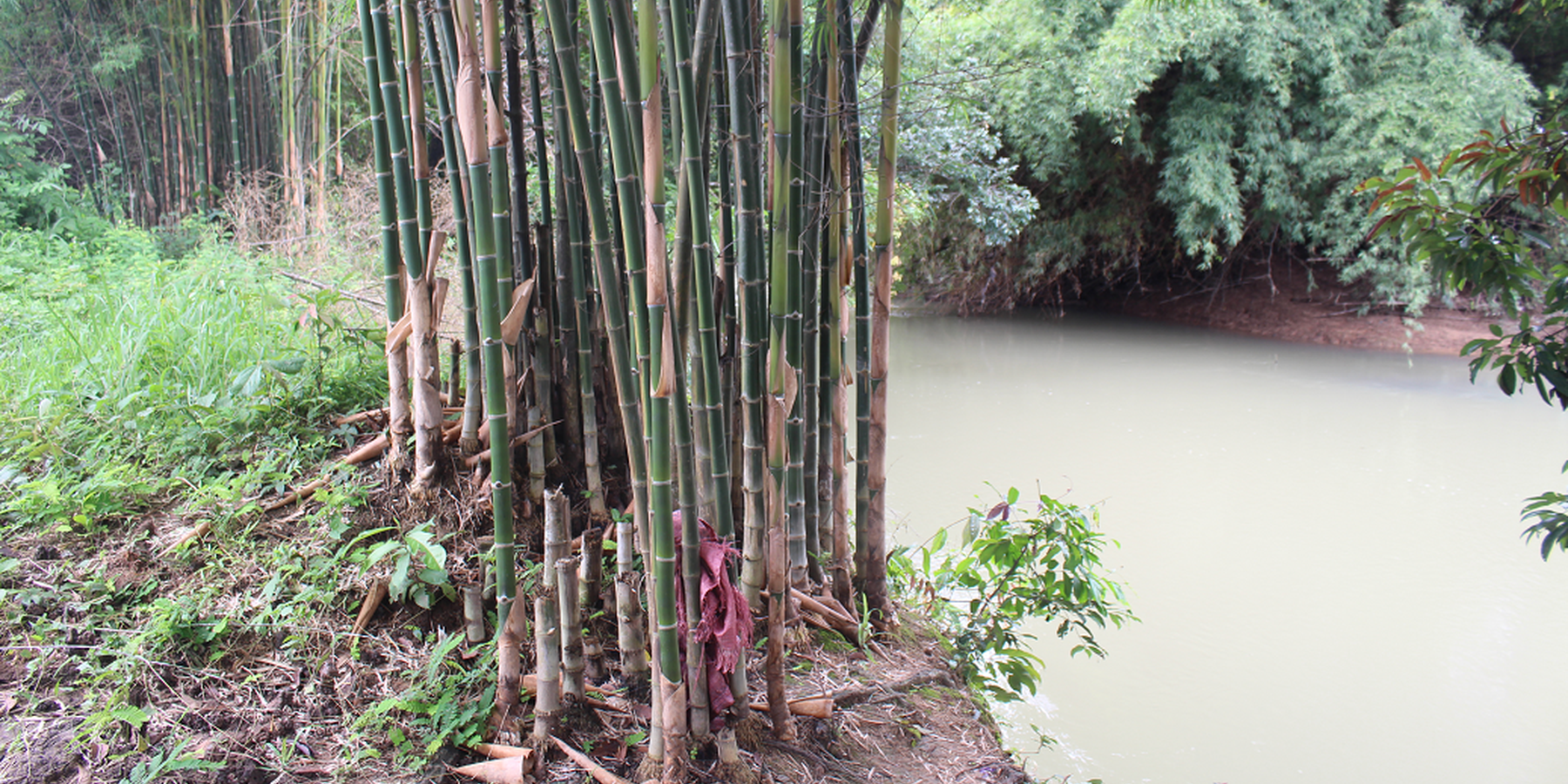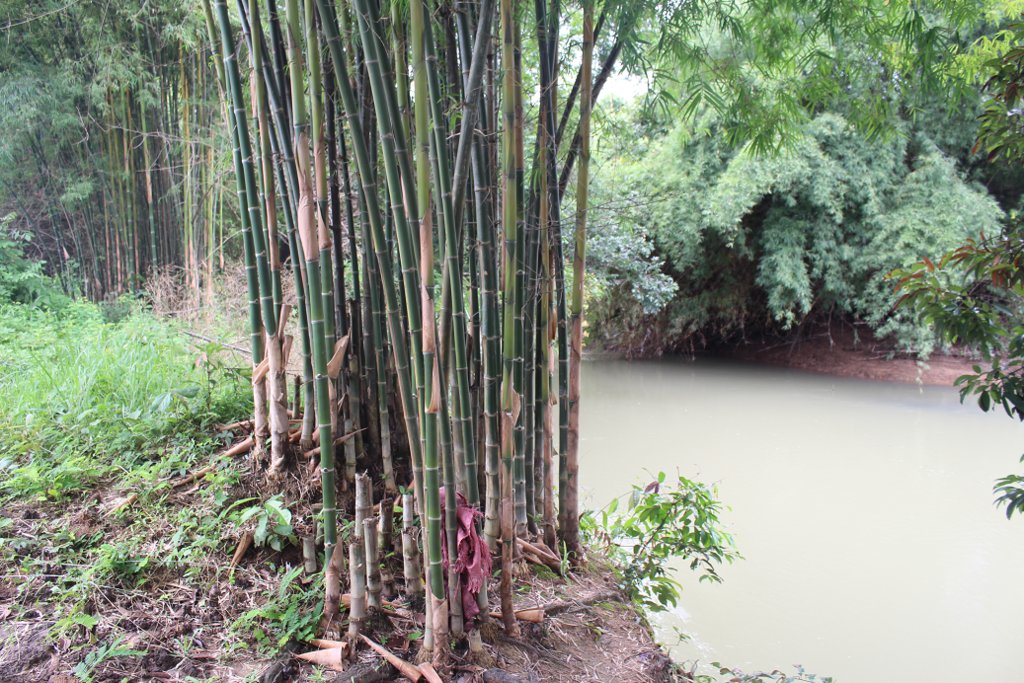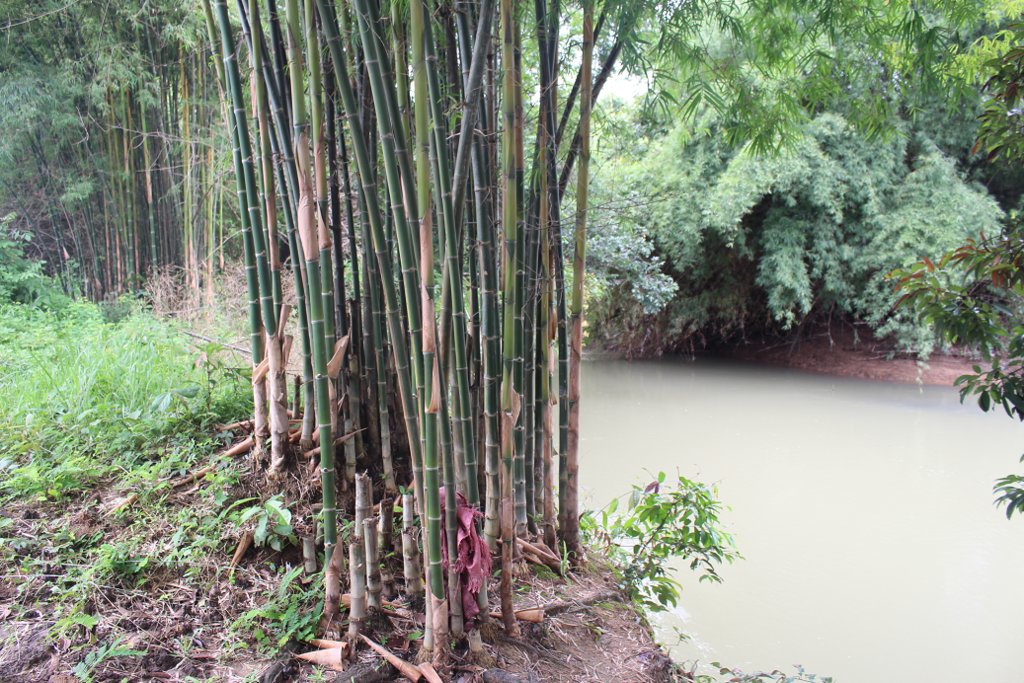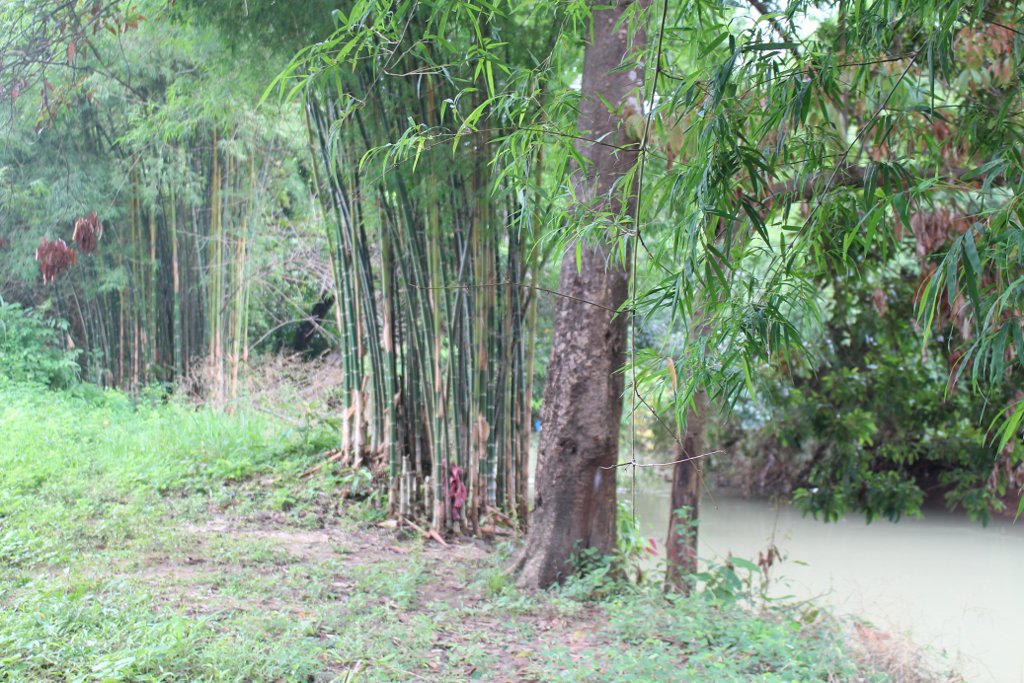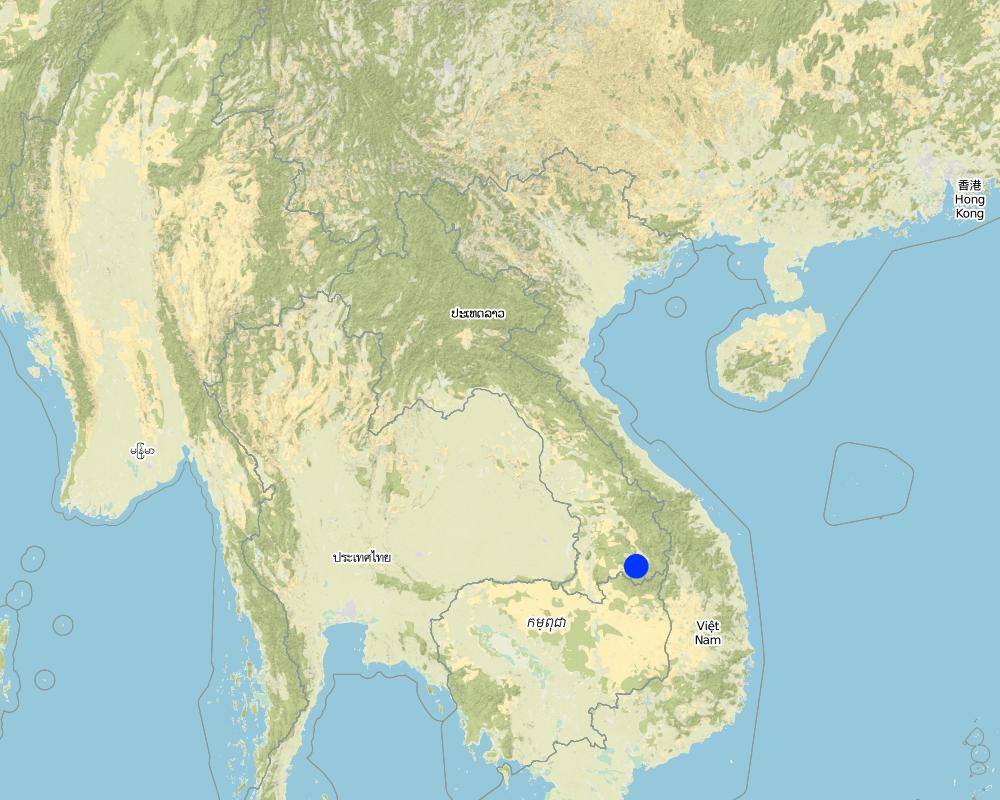Cultivation of Bamboo to Prevent Soil Erosion [Lao People's Democratic Republic]
- Creation:
- Update:
- Compiler: kang phanvongsa
- Editors: kang phanvongsa, anousit namsena, Pasalath Khounsy, Bounthanom Bouahom, Chanvilay phalivong
- Reviewers: viengsavanh phimphachanhvongsod, Nicole Harari, Stephanie Jaquet
ເຕັກນິກການປູກໄມ້ໄຜ່ ເພື່ອປ້ອງກັນດິນເຈື່ອນ
technologies_2251 - Lao People's Democratic Republic
View sections
Expand all Collapse all1. General information
1.2 Contact details of resource persons and institutions involved in the assessment and documentation of the Technology
Key resource person(s)
land user:
Kounthisuck Chansamay Chansamay
020 55948049
Vangnhang village, Phouvong District, Attapue province
Lao People's Democratic Republic
Name of project which facilitated the documentation/ evaluation of the Technology (if relevant)
Scaling-up SLM practices by smallholder farmers (IFAD)Name of the institution(s) which facilitated the documentation/ evaluation of the Technology (if relevant)
National Agriculture and Forestry Research Institute (NAFRI) - Lao People's Democratic Republic1.3 Conditions regarding the use of data documented through WOCAT
When were the data compiled (in the field)?
16/05/2017
The compiler and key resource person(s) accept the conditions regarding the use of data documented through WOCAT:
Yes
1.4 Declaration on sustainability of the described Technology
Is the Technology described here problematic with regard to land degradation, so that it cannot be declared a sustainable land management technology?
No
2. Description of the SLM Technology
2.1 Short description of the Technology
Definition of the Technology:
Mai Sangphai (Bambusa oldhamii) planting technique for soil erosion control along river bank due to soil fixation by deep and widespread roots during rainy season when there are high water levels and increased flow velocity
2.2 Detailed description of the Technology
Description:
During the rainy season when the rivers’ water levels are high and there is an increase in the velocity of the water flow, the Bambusa oldhamii (giant timber bamboo) has been especially selected to be grown along river banks because of its deep root system which effectively binds the soil thereby controlling soil erosion along river banks.
During the annual rainy season between July – October in Vangyang village (Phouvong district, Attapue province) the region experiences intense rainfall ranging from 2,500-3,000 mm/year (source: The Phouvong District Hydrology and Meteorology Office). Soil erosion occurs along riverbanks, with the end effect of gradually widening the river bed. It can be noted that the river banks in Vangyang village have already eroded by two meters which has resulted in the loss of agricultural land that was previously used to cultivate bananas and sugarcane. In order to counteract this development some of the land users initiated the planting Bambusa oldhamii on riverbanks in 2007. This strain of bamboo was selected because people could observe that the natural bamboo forest growing on opposite side of the river to their land experienced minimal soil erosion as the deep root system was able to successfully secure the soil along these stream banks. On top, Bambuse oldhamii has delicious shoots (which are consumed by land users) and less thorns compared to other wild bamboo species.
The application of this technology involves the following:
• The site should be selected along the stream banks especially where the risk of erosion is occurring. Bamboo should be planted approximately 3 meters from the edge of the bank. Bamboo is grown to protect the bank on one side of the stream from soil erosion whilst the other side of the stream is protected by natural bamboo species.
• Land preparation involves the clearance of bush around the planting pits.
• Bamboo rhizomes (Bambusa oldhamii) should be gathered locally from the parent plants. This should amount to approximately 120 healthy one-year old rhizomes each having a considerable number of feeder roots with a length of 60 to 70cm.
Forty holes measuring 50cm x 50cm and 50 cm depth should be dug in a row leaving a gap of 5 meters between each hole along the stream bank when the bamboo’s rhizome grow up it will be cover the gap for few meters from pits ( it will take about 4-5 years). After the land has been prepared 2-3 bamboo rhizomes should be replanted in each of the holes. The refilling of the holes with soil and watering should take about one day. Planting can be undertaken in January (dry season) because soil texture in dry season is less sensitive to erosion. This is a suitable time for bamboo as the roots will propagate faster. In the dry season watering needs to be done twice a week until the rhizomes establish new roots and stems. Generally, the bamboo will grow 4-5 new stems during the first year after having been replanted, but at this stage it is still unable to protect the banks from erosion. Some vegetation around the pits has been cleared before replanting and leave some vegetation on the edge to minimize erosion when the bamboo trees still young. When the bamboo is about 2-3 years old, it will be able to grow up to three times the amount of additional stems compared to its output in the first year. At this time the bamboo’s root system is able to expand more widely and deeply which helps to bind the soil and thereby it protects the stream banks from erosion during high water levels. (They left the bush and some vegetation on the edge of the stream, clearance of bush around the planting pits only) . Bamboo has multiple benefits: In fact, the older bamboo is able to provide a greater amount of protection and the bamboo shoots can either be consumed or sold by the land owners. Furthermore the bamboo culms can be used or sold for the manufacture of a variety of handicrafts. Bamboo enhances the micro-organisms habitat living in Rhizosphere (high biological activity and high nutrient availability) of the roots system and maintains the soil moisture throughout the year. The decaying bamboo leaves become a natural compost. The land owners are therefore very content and are willing to recommend the technology to their neighbors who also own land along the stream banks. The weaknesses: (1) Once the bamboo expands and grows into clumps it becomes the habitat of mosquitoes and snakes and thus weeding is required. (2) Bamboo leaves that have fallen into the water decay afterwards and deteriorate the water quality, and therefore it is recommended to cut back old branches before the leaves have the opportunity to fall into the stream.
2.3 Photos of the Technology
2.5 Country/ region/ locations where the Technology has been applied and which are covered by this assessment
Country:
Lao People's Democratic Republic
Region/ State/ Province:
Phouvong District, Attapue Province
Further specification of location:
Vangnhang Vaillage
Comments:
There are many bamboo trees in the forest along the stream but the land user who implements this technology is only in a single site in the village.
Map
×2.6 Date of implementation
Indicate year of implementation:
2007
If precise year is not known, indicate approximate date:
- less than 10 years ago (recently)
2.7 Introduction of the Technology
Specify how the Technology was introduced:
- through land users' innovation
3. Classification of the SLM Technology
3.1 Main purpose(s) of the Technology
- reduce, prevent, restore land degradation
- reduce risk of disasters
- adapt to climate change/ extremes and its impacts
3.2 Current land use type(s) where the Technology is applied

Cropland
- Perennial (non-woody) cropping

Waterways, waterbodies, wetlands
- Drainage lines, waterways
3.3 Further information about land use
other (e.g. post-flooding):
- Not require water
Comments:
Because it use water from river where they has planted
Number of growing seasons per year:
- 1
3.4 SLM group to which the Technology belongs
- surface water management (spring, river, lakes, sea)
- ecosystem-based disaster risk reduction
3.5 Spread of the Technology
Specify the spread of the Technology:
- applied at specific points/ concentrated on a small area
3.6 SLM measures comprising the Technology

vegetative measures
- V2: Grasses and perennial herbaceous plants
3.7 Main types of land degradation addressed by the Technology

soil erosion by water
- Wr: riverbank erosion
3.8 Prevention, reduction, or restoration of land degradation
Specify the goal of the Technology with regard to land degradation:
- reduce land degradation
4. Technical specifications, implementation activities, inputs, and costs
4.1 Technical drawing of the Technology
4.2 Technical specifications/ explanations of technical drawing
Bamboo is planted between the agricultural land (near the house) along the riverbank and on the other side of the river is natural bamboo and forest
Spacing between bamboo trees is 5 m
The planting holes a diameter of 50 cm and a depth of 50 cm. Distance from river edge is about 3 m
This technique is conducted in flat areas along river side
Species used is Bambusa oldhamii (Mai Sangphai )
4.3 General information regarding the calculation of inputs and costs
Specify how costs and inputs were calculated:
- per Technology unit
Specify unit:
Along the river bank
Specify volume, length, etc. (if relevant):
200 m
other/ national currency (specify):
kip
Indicate exchange rate from USD to local currency (if relevant): 1 USD =:
8000.0
Indicate average wage cost of hired labour per day:
50000 kip
4.4 Establishment activities
| Activity | Type of measure | Timing | |
|---|---|---|---|
| 1. | Collect Bamboo rhizomes (Bambusa oldhamii) from the parent plants (120 healthy one-year old rhizomes each) | Management | December |
| 2. | preparing the planting area: clear bushes | Structural | December |
| 3. | Dig the planting pits | Agronomic | January |
| 4. | planting Bamboo rhizomes, refill pits with earth | Agronomic | January |
| 5. | Water the plants (twice a week until the rhizomes establish new roots and stems). | Management |
4.5 Costs and inputs needed for establishment
| Specify input | Unit | Quantity | Costs per Unit | Total costs per input | % of costs borne by land users | |
|---|---|---|---|---|---|---|
| Labour | Labor | person-day | 5.0 | 50000.0 | 250000.0 | 100.0 |
| Equipment | Hoe | piece | 3.0 | 50000.0 | 150000.0 | 100.0 |
| Equipment | Knife | piece | 3.0 | 35000.0 | 105000.0 | 100.0 |
| Equipment | shovel | piece | 2.0 | 25000.0 | 50000.0 | 100.0 |
| Plant material | Rhizome variety | Rhizome | 120.0 | 3000.0 | 360000.0 | 100.0 |
| Total costs for establishment of the Technology | 915000.0 | |||||
4.6 Maintenance/ recurrent activities
| Activity | Type of measure | Timing/ frequency | |
|---|---|---|---|
| 1. | Weeding around planting area (between bamboo stems) | Management | Once a month |
| 2. | Replace the dead rhizome | Management | Once a year |
4.7 Costs and inputs needed for maintenance/ recurrent activities (per year)
| Specify input | Unit | Quantity | Costs per Unit | Total costs per input | % of costs borne by land users | |
|---|---|---|---|---|---|---|
| Labour | Labor | person-day | 1.0 | 50000.0 | 50000.0 | 100.0 |
| Plant material | Rhizome variety | Rhizome | 5.0 | 3000.0 | 15000.0 | 100.0 |
| Total costs for maintenance of the Technology | 65000.0 | |||||
4.8 Most important factors affecting the costs
Describe the most determinate factors affecting the costs:
Labor for maintenance is the most important effect to the cost
5. Natural and human environment
5.1 Climate
Annual rainfall
- < 250 mm
- 251-500 mm
- 501-750 mm
- 751-1,000 mm
- 1,001-1,500 mm
- 1,501-2,000 mm
- 2,001-3,000 mm
- 3,001-4,000 mm
- > 4,000 mm
Specify average annual rainfall (if known), in mm:
1500.00
Specifications/ comments on rainfall:
Precipitation is the lowest in January. Most precipitation falls in July - October , with an average of 566 mm in that period
Indicate the name of the reference meteorological station considered:
Phouvong District of Natural Resources and Environment Office
Agro-climatic zone
- sub-humid
5.2 Topography
Slopes on average:
- flat (0-2%)
- gentle (3-5%)
- moderate (6-10%)
- rolling (11-15%)
- hilly (16-30%)
- steep (31-60%)
- very steep (>60%)
Landforms:
- plateau/plains
- ridges
- mountain slopes
- hill slopes
- footslopes
- valley floors
Altitudinal zone:
- 0-100 m a.s.l.
- 101-500 m a.s.l.
- 501-1,000 m a.s.l.
- 1,001-1,500 m a.s.l.
- 1,501-2,000 m a.s.l.
- 2,001-2,500 m a.s.l.
- 2,501-3,000 m a.s.l.
- 3,001-4,000 m a.s.l.
- > 4,000 m a.s.l.
Indicate if the Technology is specifically applied in:
- not relevant
5.3 Soils
Soil depth on average:
- very shallow (0-20 cm)
- shallow (21-50 cm)
- moderately deep (51-80 cm)
- deep (81-120 cm)
- very deep (> 120 cm)
Soil texture (topsoil):
- medium (loamy, silty)
Soil texture (> 20 cm below surface):
- medium (loamy, silty)
Topsoil organic matter:
- medium (1-3%)
5.4 Water availability and quality
Ground water table:
< 5 m
Availability of surface water:
good
Water quality (untreated):
for agricultural use only (irrigation)
Is water salinity a problem?
No
Is flooding of the area occurring?
Yes
Regularity:
episodically
5.5 Biodiversity
Species diversity:
- medium
Habitat diversity:
- medium
5.6 Characteristics of land users applying the Technology
Sedentary or nomadic:
- Sedentary
Market orientation of production system:
- subsistence (self-supply)
Off-farm income:
- > 50% of all income
Relative level of wealth:
- average
Individuals or groups:
- individual/ household
Level of mechanization:
- manual work
Gender:
- men
Age of land users:
- middle-aged
5.7 Average area of land owned or leased by land users applying the Technology
- < 0.5 ha
- 0.5-1 ha
- 1-2 ha
- 2-5 ha
- 5-15 ha
- 15-50 ha
- 50-100 ha
- 100-500 ha
- 500-1,000 ha
- 1,000-10,000 ha
- > 10,000 ha
Is this considered small-, medium- or large-scale (referring to local context)?
- small-scale
5.8 Land ownership, land use rights, and water use rights
Land ownership:
- individual, not titled
Land use rights:
- individual
Water use rights:
- open access (unorganized)
5.9 Access to services and infrastructure
health:
- poor
- moderate
- good
education:
- poor
- moderate
- good
technical assistance:
- poor
- moderate
- good
employment (e.g. off-farm):
- poor
- moderate
- good
markets:
- poor
- moderate
- good
energy:
- poor
- moderate
- good
roads and transport:
- poor
- moderate
- good
drinking water and sanitation:
- poor
- moderate
- good
financial services:
- poor
- moderate
- good
6. Impacts and concluding statements
6.1 On-site impacts the Technology has shown
Socio-economic impacts
Production
production area
Comments/ specify:
Before planting bamboo the production area was gradually damaged by stream bank erosion, after bamboo has been planted the production area loss was minimized
Income and costs
workload
Comments/ specify:
In addition to the agricultural activities the farmer has to maintain their bamboo (cut stems, weed) Otherwise it will grow dense and difficult to pass in to harvest the shoots or stems
Socio-cultural impacts
recreational opportunities
Comments/ specify:
Bamboo could provide shade relaxing place along the stream bank for picnic or fishing
Ecological impacts
Soil
soil loss
Comments/ specify:
previously: soil loss by water erosion; after bamboo has been planted and grown up the soil was protected by bamboo's root system
Climate and disaster risk reduction
landslides/ debris flows
Comments/ specify:
In the past approximate 2 meters loss of land along stream bank, after bamboo has been planted no more land has been lost in the protected area
6.2 Off-site impacts the Technology has shown
downstream siltation
Comments/ specify:
Downstream siltation is decreased due to less eroded soil.
6.3 Exposure and sensitivity of the Technology to gradual climate change and climate-related extremes/ disasters (as perceived by land users)
Gradual climate change
Gradual climate change
| Season | Type of climatic change/ extreme | How does the Technology cope with it? | |
|---|---|---|---|
| seasonal rainfall | wet/ rainy season | decrease | moderately |
6.4 Cost-benefit analysis
How do the benefits compare with the establishment costs (from land users’ perspective)?
Short-term returns:
slightly negative
Long-term returns:
positive
How do the benefits compare with the maintenance/ recurrent costs (from land users' perspective)?
Short-term returns:
neutral/ balanced
Long-term returns:
slightly positive
6.5 Adoption of the Technology
- 1-10%
Of all those who have adopted the Technology, how many have did so spontaneously, i.e. without receiving any material incentives/ payments?
- 90-100%
6.6 Adaptation
Has the Technology been modified recently to adapt to changing conditions?
No
6.7 Strengths/ advantages/ opportunities of the Technology
| Strengths/ advantages/ opportunities in the land user’s view |
|---|
| Helps to protect the soil from erosion |
| The bamboo shoots can be consumed as well as sold, and the bamboo culms can also be sold for the manufacture of handicrafts |
| Enhances the micro-organisms habitat living in Rhizoshere (high biological activity and high nutrient availability) of the roots system |
| Strengths/ advantages/ opportunities in the compiler’s or other key resource person’s view |
|---|
| Bamboo has a considerable number of roots which help to effectively bind the soil |
6.8 Weaknesses/ disadvantages/ risks of the Technology and ways of overcoming them
| Weaknesses/ disadvantages/ risks in the land user’s view | How can they be overcome? |
|---|---|
| Once the bamboo expands and grows into clumps it becomes the habitat of mosquitoes and snakes | thus weeding is required; |
| the falling leaves in water decay and deteriorate water quality, | thus it is recommended to trip old branches before its leaves fall down into streams. |
7. References and links
7.1 Methods/ sources of information
- field visits, field surveys
1 place
- interviews with land users
1 person
Links and modules
Expand all Collapse allLinks
No links
Modules
No modules


